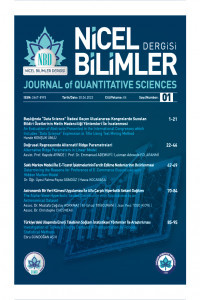Combating Multicollinearity: A New Two-Parameter Approach
LKL Estimator, OLS Estimator, Monte Carlo Simulation
Combating Multicollinearity: A New Two-Parameter Approach
Combating Multicollinearity, monte carlo, ols estimator,
___
- [1] Chatterjee, S. and Hadi, A. S., Regression Analysis by Example, 4th ed., NJ: John Wiley and Sons, 2006.
- [2] Chatterjee, S., Hadi, A. S. and Price, B., Regression by example, 3rd ed., New York: John Wiley and Sons, 2000.
- [3] G. S. Maddala, Introduction to econometrics, 3rd ed., England: John Willey and Sons Limited, 2002.
- [4] W. H. Greene, Econometric analysis, 5th ed., New Jersey: Prentice-Hall Saddle River, 2003.
- [5] Lukman A.F. and Ayinde, K., "Review and classifications of the ridge parameter estimation techniques," Hacettepe Math Stat., vol. 46, no. 5, p. 953‐967, 2017.
- [6] W. F. Massy, "Principal component regression in exploratory statistical research," Journal of the American Statistical Association, vol. 60, p. 234 –246, 1965.
- [7] D. W. Marquardt, "Generalized inverse, ridge regression, biased linear estimation and non – linear estimation," Technometrics, vol. 12, p. 591–612, 1970.
- [8] Naes, T., and Marten, H., "Principal component regression in NIR analysis: Viewpoints, background details selection of components," Journal of Chemometrics, vol. 2, p. 155 – 167, 1988.
- [9] A. E. Hoerl, "Application of ridge analysis to regression problems," Chemical Engineering Progress, vol. 58, p. 54 –59, 1962.
- [10] Hoerl, A. E., and Kennard, R. W., "Ridge regression biased estimation for non-orthogonal problems," Technometrics, p. 27–51, 1970.
- [11] I. S. Helland, "On the structure of partial least squares regression," Communication is Statistics, Simulations and Computations, vol. 17, p. 581–607, 1988.
- [12] I. S. Helland, "Partial least squares regression and statistical methods," Scandinavian Journal of Statistics, vol. 17, p. 97 – 114, 1990.
- [13] Phatak, A. and Jony, S. D., "The geometry of partial least squares," Journal of Chemometrics, vol. 11, p. 311–338, 1997.
- [14] Lukman, A. F., K. Ayinde, S. K. Sek, and E. Adewuyi, "A modified new two-parameter estimator in a linear regression model," Modelling and Simulation in Engineering 2019:6342702, 2019.
- [15] Kibria, B.M.G. and Lukman, A.F., "A New Ridge-Type Estimator for the Linear Regression Model: Simulations and Applications," Scientifica, p. 1–16, 2020.
- [16] K. Liu, "A new class of biased estimate in linear regression," Commun. Stat.-Theory and Methods, vol. 22, p. 393–402, 1993.
- [17] Yang, H. and Chang, X., "A new two-parameter estimator in linear regression," Commun. Stat.-Theory and Methods, vol. 39, no. 6, p. 923–934, 2010.
- [18] Kaciranlar, S., Sakallioglu, S., Akdeniz, F., Styan, G.P.H. and Werner, H.J., "A new biased estimator in linear regression and a detailed analysis of the widely– analyzed dataset on portland cement," Sankhya 61, p. 443–459, 1999.
- [19] Wang, S.G., Wu, M.X. and Jia, Z.Z., Matrix Inequalities, 2nd ed., Beijing: Chinese Science Press, 2006.
- [20] R. Farebrother, "Further results on the mean square error of ridge regression," J R Stat Soc. , vol. B38, p. 248‐250, 1976.
- [21] Trenkler, G. and Toutenburg, H. , "Mean squared error matrix comparisons between biased estimators-an overview of recent results," Stat Pap. , vol. 31, no. 1, p. 165‐179, 1990.
- [22] A. V. Dorugade, "New Ridge Parameters for Ridge Regression," Journal of the Association of Arab Universities for Basic and Applied Sciences, pp. 1-6, 2016.
- [23] Saleh, A. K. M. E.; Arashi, M. and Kibria, B. M. G., Theory of Ridge Regression Estimation with Applications., New Jersey: Wiley, Hoboken., 2019.
- [24] Aslam, M. & Ahmad, S., "The modified Liu-ridge-type estimator: a new class of biased estimators to address multicollinearity," Communications in Statistics - Simulation and Computation, 2020.
- [25] McDonald, G. C., and Galarneau, D. I., "A Monte Carlo evaluation of some ridge-type estimators," Journal of the American Statistical Association, vol. 70, pp. 407-416, 1975.
- [26] Wichern, D. and Churchill, G., "A Comparison of Ridge Estimators," Technometrics, vol. 20, p. 301–311, 1978.
- [27] B. M. Kibria, "Performance of some new ridge regression estimators," Communications in Statistics - Simulation and Computation, vol. 32, pp. 419-435, 2003.
- [28] Newhouse, J. P., and Oman, S. D., "An evaluation of ridge estimators.," A report prepared for the United States air force project RAND, 1971.
- [29] Woods, H.; Steinour, H. H., and Starke, H. R., "Effect of composition of Portland cement on heat evolved during hardening," Industrial & Engineering Chemistry, vol. 24, no. 11, p. 1207–1214, 1932.
- [30] Li, Y. and Yang, H., "A new Liu-type estimator in a linear regression model," Stat. Pap. , vol. 53, p. 427–437, 2012.
- [31] Ayinde, K.; Lukman, A.F.; Samuel, O.O.; & Ajiboye, S.A., "Some new adjusted ridge estimators of linear regression model," Int. J. Civ. Eng. Technol., vol. 9, no. 11, p. 2838‐2852, 2018.
- [32] J. Longley, "An appraisal of least-squares programs for electronic computer from the point of view of the user," J. Am. Stat. Assoc., vol. 62, p. 819–841, 1967.
- [33] Dawoud, I. and Kibria, B. M. G., "A New Biased Estimator to Combat the Multicollinearity of the Gaussian Linear Regression Model," Stats, vol. 3, no. 4, pp. 526-541, 2020.
- ISSN: 2667-8993
- Yayın Aralığı: Yılda 2 Sayı
- Başlangıç: 2019
- Yayıncı: Eskişehir Osmangazi Üniversitesi
İsa GÜL, Özlem GEDİK, Mustafa CANBAZ, Sinan SARAÇLI
Avrupa Birliği'nde Ekonomik Güvenlik ve Fiziksel Güvenlik: Çok Değişkenli Bir İstatistiksel Analiz
H. Hilal BAĞLITAŞ, Hayriye ATİK
Türkiye Pay Piyasası Etkinliğinin Çok Ölçekli Sample Entropi ile Analizi
Beste Buse YILDIRIM, Mehmet YILMAZ
Combating Multicollinearity: A New Two-Parameter Approach
Janet Iyabo IDOWU, Olasunkanmi James OLADAPO, Abiola Timothy OWOLABİ, Kayode AYİNDE, Oyinlade AKİNMOJU
